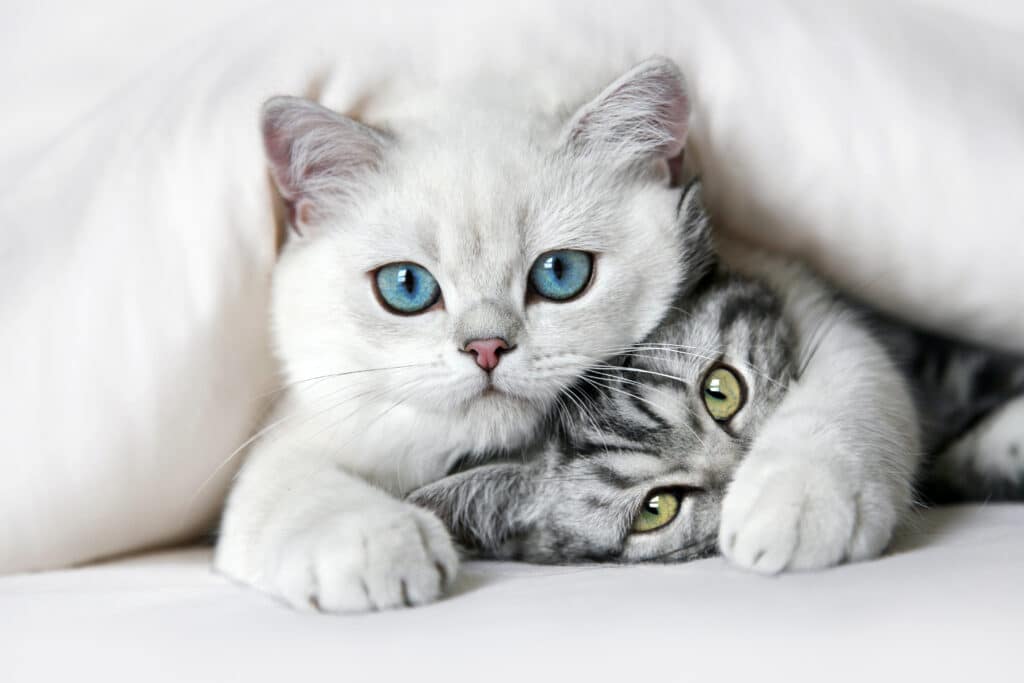FLUTD cat or FLUTD is a collective term for various diseases of the lower urinary tract in cats, including the bladder and urethra, which are associated with difficulty and pain during urination. FLUTD stands for “Feline Lower Urinary Tract Disease” and is made up of the first letters of the English term.

Which cats are affected by FLUTD?
As a rule, indoor cats are generally affected by FLUTD. Outdoor cats almost never suffer from this disease, while animals in multi-cat households are more susceptible. Obesity, lack of exercise, feeding (predominantly or exclusively) dry food and stress further increase the risk of this disease. Stress factors can include moving or family changes such as the arrival of a baby or a new partner.
Trigger for FLUTD
There are essentially three triggers for FLUTD:
- The disease is very often caused by a sterile cystitis of unknown cause, which is known idiopathic cystitis Veterinarians suspect that stress is ultimately responsible for the nerve irritation in the bladder wall. In male cats, shed inflammatory cells in the urine can be life-threatening because their urethra is severely narrowed towards the tip of the penis. A clot of mucous membrane particles can quickly block the ureter, resulting in a sand-shaped bladder that blocks the flow of urine.
- Bladder semolina is also often responsible for painful urinary tract infections. Cats are very prone to developing such urinary crystals, whose sharp edges can irritate the bladder wall. As former desert dwellers, cats have the ability to reabsorb a lot of water from the urine produced in their kidneys and to conserve water, which means that mineral salts such as typically struvite or calcium oxalate are relatively easy to precipitate.
- A bacterial bladder infection can also cause FLUTD, but is rare in cats.
Symptoms in the FLUTD cat
Symptoms of FLUTD include strong urge to urinate, dribbling when urinating, blood in the urine , and pain when trying to empty the bladder . Many cats scream in pain. In severe cases, the urethra can even become completely blocked due to bladder debris, inflammatory cells or cramps. After a few hours, the bladder is tense enough to rupture and fills half of the abdominal cavity. If urinary toxins accumulate in the body due to a lack of urination, electrolyte shifts in the blood also occur.
Elevated potassium levels are dangerous and cardiac arrhythmias . This condition is life-threatening and the animal should be taken to the veterinary clinic as an emergency. In the late stages, urinary retention can extend into the kidney tissue, which can lead to acute kidney failure. If the condition is not treated, the patient may die.
Treating a FLUTD cat
Treatment for FLUTD depends on the cause and severity of the condition. For cats that are prone to struvite crystals , for example, special diet food prevent the formation of new bladder stones.
- If urinary obstruction is present, it may be necessary to insert a catheter into the animal under anesthesia to empty and flush the bladder.
- For milder forms of FLUTD, intravenous infusion therapy be sufficient to flush the urinary tract and normalize kidney values. Anti-inflammatory medications are often also used.
- If a spasm has led to blockage muscle relaxants administered.
- In more severe cases , especially if the tip of the penis is narrowed, only surgical widening of the urethra is ultimately possible.
Can FLUTD be prevented?
Unfortunately, the risk of recurrence of FLUTD is very high, especially in cats that have had idiopathic cystitis. Appropriate FLUTD management at home can help minimize the risk of recurrence.
- For example, we recommend increasing the amount of water you drink by offering several drinking options in the apartment.
- Separate feeding areas also recommended.
- Switching from dry to wet food can also make sense.
- If the animal overweight , you can promote the urge to move through games and climbing opportunities and offer low-calorie food
- There should always enough clean litter boxes available. Stressors should be avoided or reduced, and in some cases cat-specific pheromones can also be used to reduce aggression between cats.
- Stressors should be avoided or reduced, and in some cases cat-specific pheromones can also be used to reduce aggression between cats.
